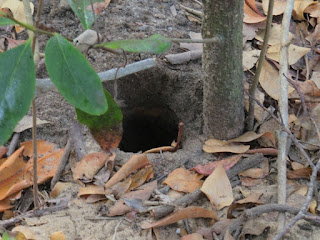A few days ago, I
was cruising along a rock coastline near Cairns when I realised that
many of the floating objects had a passenger. Photographing these
passengers is ridiculously hard as they hide on the other side of the
object when you approach and everything is vigorously bobbing up and
down. In smooth weather, one also has to consider that Irukandji
jellyfish are likely to be present. These small jellyfish which are
as clear as ice are occasionally lethal. Irukandji and their relatives hunt for
copepods at the water surface in glassy weather. Irukandji jellyfish kill by inducing so much pain that people can and do die. That would not be a nice
experience on a remote coastline and I fear these creatures more than
sharks and crocodiles. Tourists should go on organised tours to minimise the risk of jellyfish sting.
 |
| Rocky coastline near Cairns |
I did manage to
photograph a couple of creatures that one would not expect to be
floating around the sea on bits of mangrove. The first creature was a
sea hare and the second a crab.
 |
| Sea hare on a stilt mangrove propagule |
 |
| Crab on a floating branch about 1 km from land |
I really do not know
why animals ride on floating objects. It would seem that the risk of
being taken out to sea or getting washed up on a beach would be so
high that it would almost suicidal. It obviously takes these animals
some deliberate effort to find a floating object. For example, I
have never found a sea hare any near a mangrove swamp, they are an
animal of the sub-tidal zone. Likewise the crab has chosen to ride
the branch. It is unlikely that the crab just happened to be on the
branch when it started floating. Most of the animals that associate with floating mangrove material also have planktonic larval stages so they do not need mangrove help to disperse.
One day I would like
to do a proper job of photographing mangrove hitchhikers because
there are so many of them. Many actually mimic common floating
mangrove debris including orange leaves, specks of bark and even thin
green eel grass leaves. The only thing that is not mimicked to my
knowledge are mangrove flowers.


